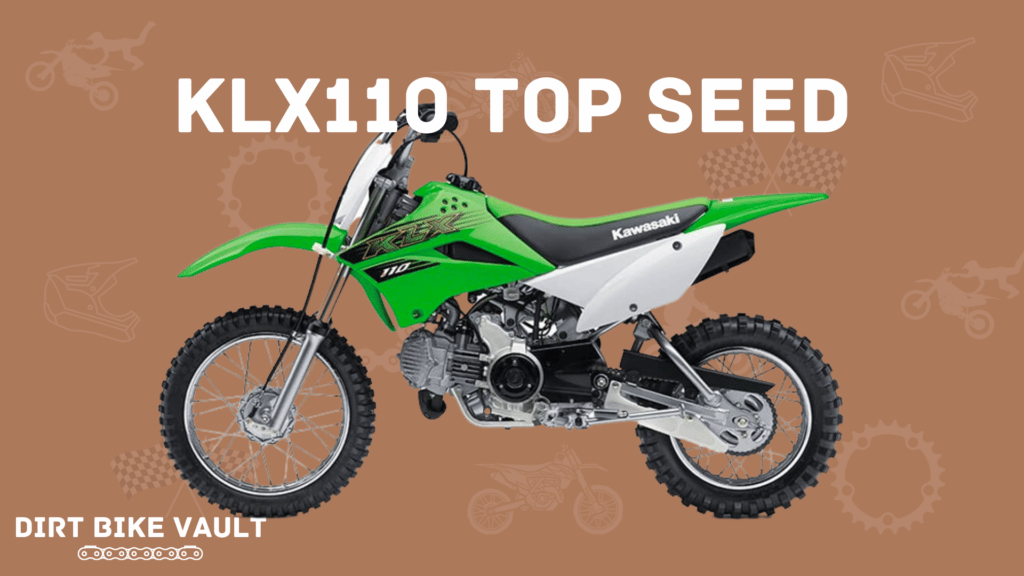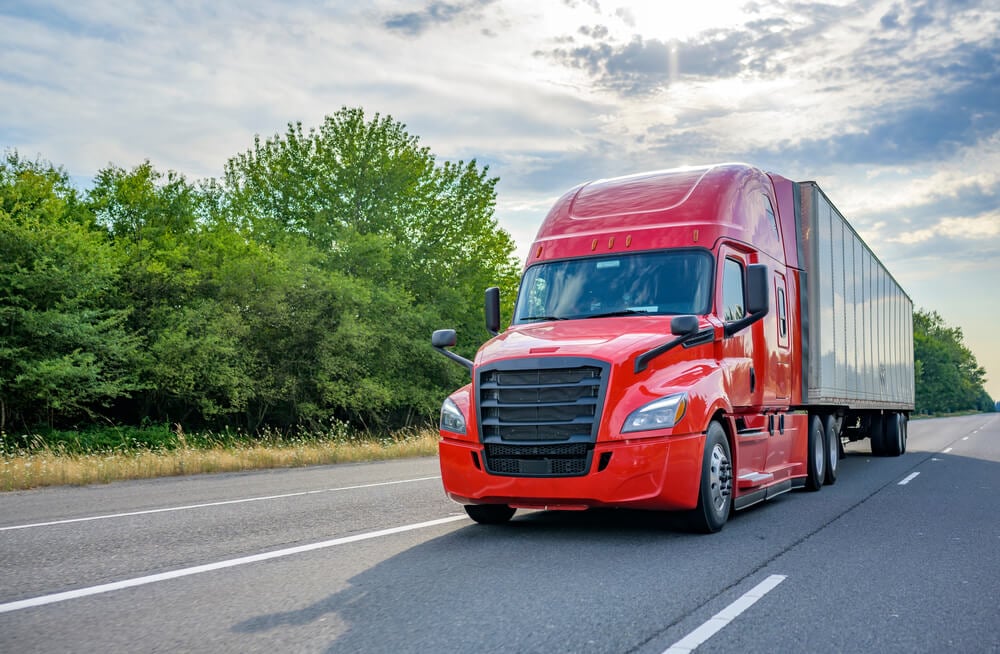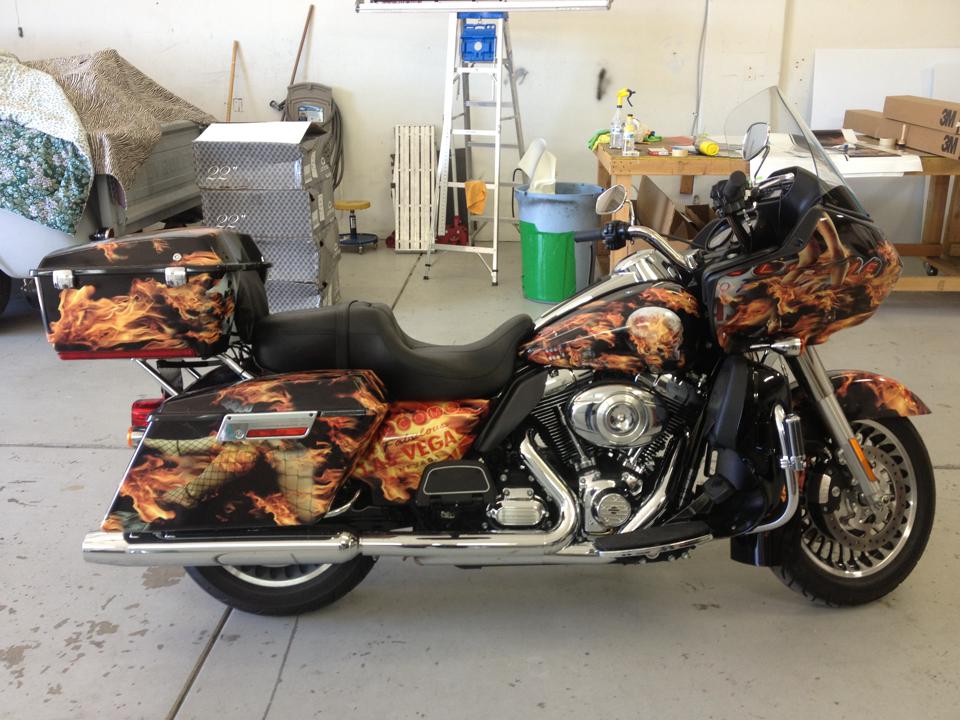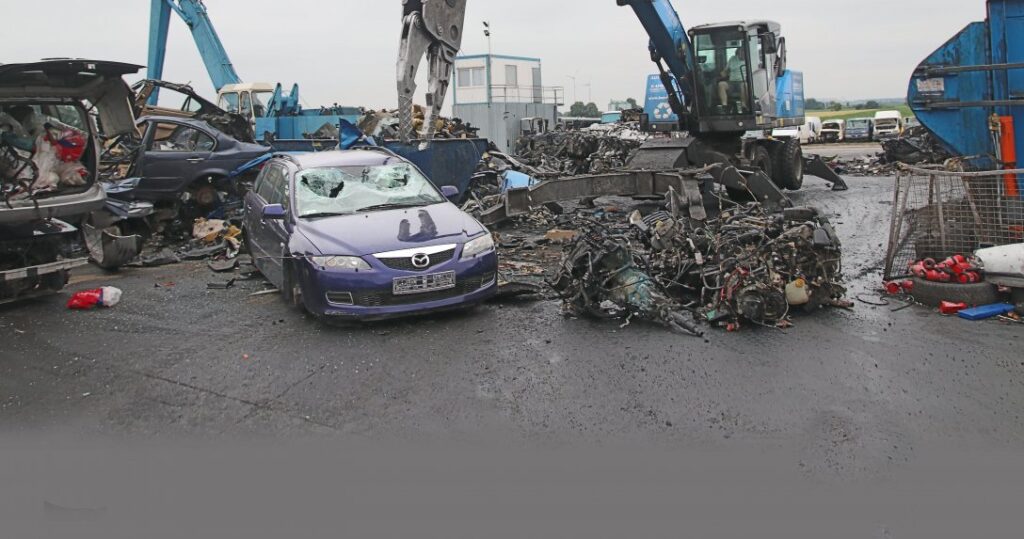If you’re in the pit bike racing world, you’ve definitely heard of the debate about which brand 110 is the fastest. Is the top speed of KLX 110 the fastest, or is it Honda’s CRF110, or is it maybe old-faithful, the KLX110?
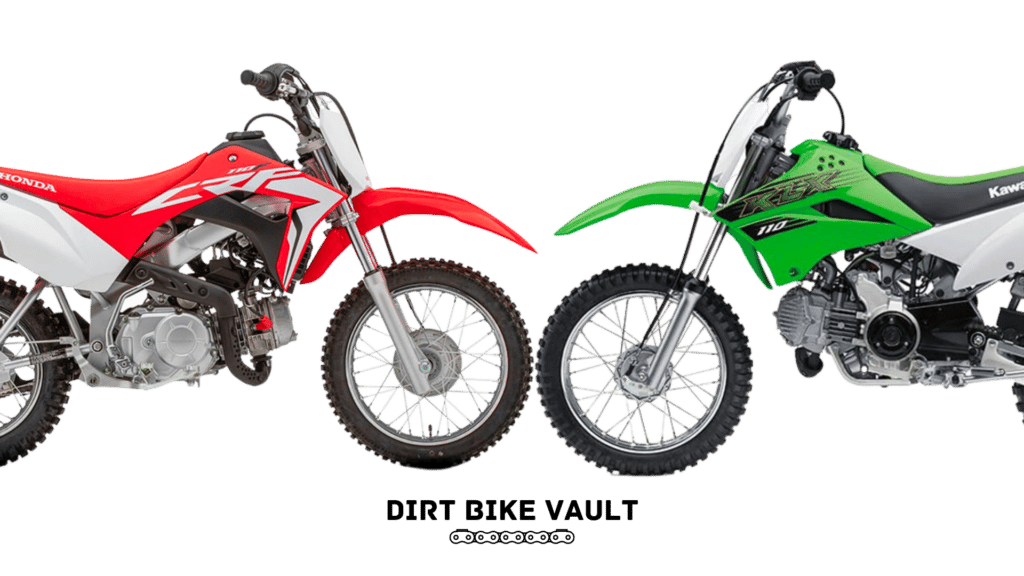
In this post, we’ll cover what the KLX 110 top speed is and what impacts it.
KLX 110 Top Speed
Kawasaki has long been one of the dominant players in the dirt bike world, especially in the youth motocross bike world, and of course, the pit bike world, with bikes such as the KLX 110.
I remember watching a video of Adam Cianciarulo riding at Ricky Carmichael‘s house when he was a kid and it made me love Kawasaki (and Cianciarulo). At that point, he was the youngest kid I had seen with serious support from a major manufacturer. This was back before it was as common as it is nowadays.
But, popularity and my enjoyment for the brand doesn’t make a bike fast, so what does this mean for the KLX 110 top speed?
The KLX 110 top speed is about 45 mph.
This is about 1-2 mph faster than the CRF110 top speed. It’s also about 1-2 mph slower than the TTR 110 top speed.
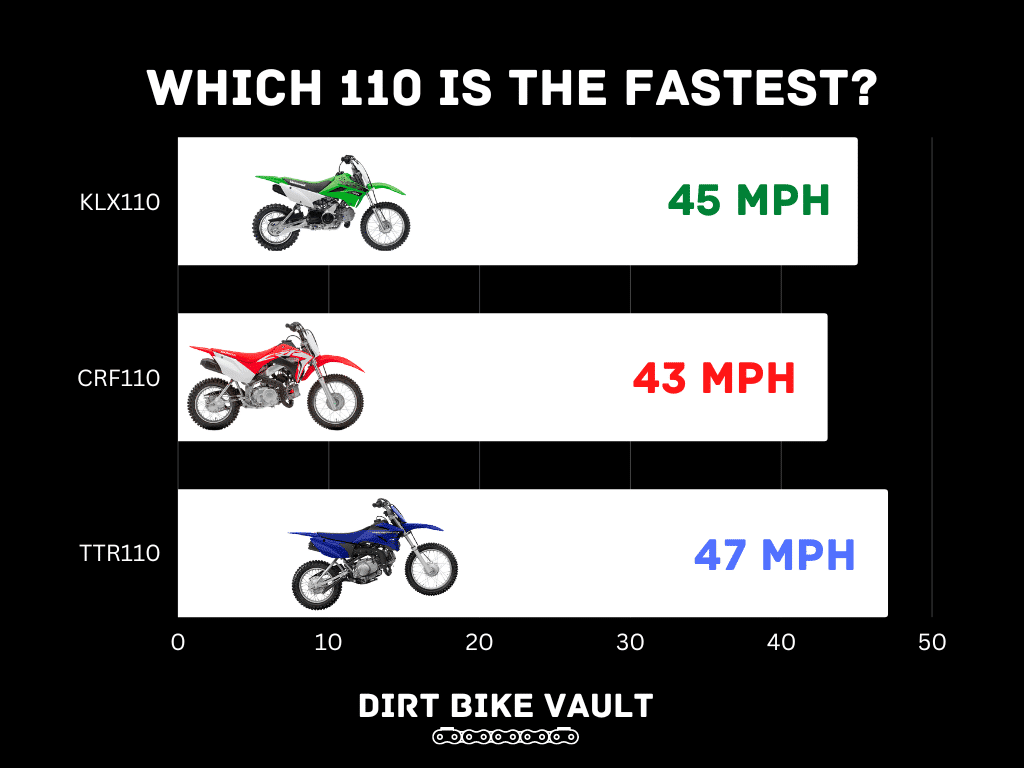
Why did I pick these two bikes to compare the KLX 110?
The CRF110 and TTR 110 were both chosen to compare the KLX 110 to because they are the most common pit bikes people ride and race. There are other brands, like a Kayo dirt bike, an XPro, YCF, Piranha, and others, but the KLX, CRF, and TTR are the most common 110 pit bikes.
What changes the top speed of a KLX 110?
It can be tough at times to calculate the true top speed of a dirt bike, including pit bikes, because there are quite a few different items that can impact it. Let’s take a look at what those variables are.
Engine Work and Aftermarket Parts
This might be obvious to some, but engine work and aftermarket parts are going to impact the KLX 110 top speed. Arguably, most of anything.
If your KLX 110 has engine work (especially a big bore kit) and a pipe, that’s not really comparable to the top speed of a stock KLX 110.
The top speed of KLX 110 that hasn’t had any work done to it will be lower than the top speed of KLX 110 that has undergone mods.
The more work you do to the bike, the greater the difference in speeds will be.
There are other factors at play here too – such as gearing, riding conditions, and more.
Gearing
The second most important factor in determining the KLX 110 top speed is the bike’s gearing. Gearing refers to the size (and ratio) of the front and rear sprockets.
For reference, the stock gearing for this bike is a 13-tooth front sprocket and a 38-tooth rear sprocket (depending on the year of your bike).
My KLX110 currently has a 13-tooth front sprocket and a 39-tooth rear sprocket, but I just changed the rear sprocket to go up one tooth at a race this past weekend.
Riders normally pick different gearing depending on the situation they’re riding. If the rider is racing supercross style, they would typically want more acceleration (referred to as more bottom end). To achieve this, they’d use either a smaller front sprocket or a larger rear one. This is known as having a low gear ratio.
I know pit bike riders aren’t racing traditional Monster Energy Supercross on their 110s, but there are some indoor arenacross or supercross-style races in the winter for pit bikes, and there are even outdoor tracks that are small a supercross-like.
If the rider is racing a more open, motocross-type track, they may want more top speed (known as top end). To do this, the rider would use a larger front sprocket or a smaller rear sprocket; in other words, they would be changing to a higher gear ratio.
Riding in the woods can require an entirely different gearing combination than that of supercross or motocross.
This might not sound like much to some people, but it has a large impact on the top speed of KLX 110 (or any dirt bike, for that matter). Depending on the gear changes made, it can increase or decrease the KLX 110 top speed by an impactful amount.
A KLX 110 with a 6-tooth front sprocket will have a different top speed than one with the stock 13-tooth front sprocket (I made the difference wide to make a point — no one is running a 6-tooth front sprocket on their KLX 110….).
Additionally, a change to the front sprocket has a great effect on the KLX 110 top speed and bottom end than changing the rear sprocket. Going up or down one tooth on the front sprocket is not equal to one tooth on the rear sprocket.
Rather, changing the front sprocket by one tooth is equivalent to 3-4 teeth in the rear.
Rider: Size and Ability
The top speed of KLX 110 is going to be slower if the rider weighs more because it takes more work from the bike, while the bike and engine maintain the same ability/capacity. The heavier the rider, generally the lower the KLX 110 top speed is going to be.
A KLX110 is designed for kids, so if a kid is riding it who weighs 60 pounds, that’s entirely different than a full-grown adult riding it as a pit bike.
Riding Conditions
The KLX 110 top speed can also be impacted by riding conditions, including both location and surface.
For example, a dirt bike’s power output is generally higher closer to sea level than at high altitudes. So if you’re planning to ride your KLX 110 in the mountains, it will likely have a lower top speed than if you were riding at sea level.
Or, even if you’re not in the mountains necessarily, but you’re just riding in Colorado, you’re much higher above sea level than the coasts of the US. That will cause your KLX 110 top speed to be lower.
Smaller-size bikes (bikes with small cc engines) are more impacted by elevation changes than larger bikes, too. For example, a KLX110 is impacted more than a KX250F, and a KX250F top speed is more impacted than a YZ450F top speed.
Are you riding in the woods, on a motocross track, or on a paved road? If it’s in the woods, your top speed might be limited. If you’re racing motocross, you can only go so fast while remaining safe and within bounds (and, don’t forget, sometimes slow is fast).
Apart from the elevation and location, another factor that affects the KLX 110 top speed is the surface on which it is being ridden. The top speed of KLX 110 ridden on flat pavement will be different than if it were driven on a tight, sandy motocross course; even the type of tires can make a difference.
A Few Other Factors that Can Impact the KLX 110 Top Speed
Your KLX 110 top speed can also be impacted by a few more things, including the condition of your bike, the weather, and how you’re recording the data.
A bike that is regularly maintained will run faster and more efficiently than one that isn’t. For example, a KLX 110 that has had consistent maintenance done to it will be able to reach a higher top speed than one not taken care of properly.
The weather and temperature can both affect your KLX 110 top speed. If it rains, the pavement will be wet and your top speed will probably be lower than normal. Similarly, if it’s an abnormally cold or hot day, that could impact how well the bike is running, which could then lower the top speed.
If you want to get an accurate reading of the top speed of KLX 110, use an onboard GPS device rather than relying on someone pointing a speed gauge at you as you zoom past. This doesn’t mean the bike will actually go any faster or slower, it just changes what you end up seeing on paper.
Top speed of a KLX 110
Ultimately, most people want to know their bike’s rough top speed. Yes, mods and other items impact a KLX 110 top speed potential, but at the end of the day, people just want to have an idea of how fast their bike is.
They don’t really care if it’s 11 or 12 mph, but they care if it’s 5 mph or 50 mph.
With that in mind, a KLX 110 top speed is about 45 mph.
Frequently Asked Questions About the KLX 110 Top Speed
Yes, I have owned multiple KLX110 bikes and have owned them for years — they’ve always been good bikes for me. There’s a reason why they were always one of the most popular 110 models.
The regular KLX110 model does not have a clutch, but the KLX110L model does have a clutch. The name looks very similar, so be sure to look out for the L at the end to determine if the bike comes with a clutch or not.
A KLX110 is designed to be a kid’s bike, but I have seen, personally, many adults upwards of 175-200 pounds riding them. The KLX110 isn’t designed for it, but it can do it. If you start getting much over 200 pounds, I likely would get away from the KLX110.
No, the KLX110 is not a race bike. Kawasaki classifies it as a trail bike and a youth bike. However, KLX110s are very commonly raced in pit bike series.
Yes, the newer KLX110 models do come with electric start.
Yes, adults can ride a KLX110. It’s made for children, but adults can ride them too.
A Kawasaki KLX110 has four (4) gears.
No, Kawasaki KLX110 bikes do not come with keys.
No, the KLX110 is not fuel injected. I’m hoping that Kawasaki will come out with a fuel-injected model in the near future, but as of now, the KLX110 is not fuel injected.
